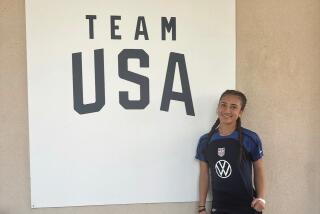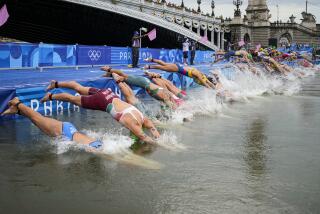An Enduring Passion : Triathletes of All Ages Quickly Get Hooked on Their Sport’s Rigors
- Share via
Brad Kearns won the Oxnard Sports Festival triathlon Sunday and Charlie Gooding finished last, but they really aren’t as far apart as it might seem.
Granted, Kearns, a former Taft High cross-country runner, has made a career of triathlons, spending his days running, swimming and bicycling in preparation for competition. Meanwhile, the Sunland-based Gooding must plan his training around his work schedule at a large computer firm.
And although Kearns goes to triathlons wearing clothing donated by sponsors and anticipating big earnings from each event, Gooding, who puts his earnings from work toward purchasing bike equipment and wet suits, must leave the race course with nothing more than bolstered pride.
“This was my second race. It was encouraging to see people at the end chanting my name, calling for me to finish,” said Gooding, a 59-year-old grandfather of 12. “The swimming part interested me and I decided to try this. The competition got me to try the training and be disciplined so I could do well. Now I am just glad that I finished.”
Yet for all that separates them, both Kearns, 25, and Gooding have centered their lives on the need for speed, strength and endurance. They, like many of the 700 other athletes who competed, admit to an almost unhealthy obsession with a sport that seems to welcome only the fittest, mentally and physically.
“My advice to people when they start is to have fun with it and don’t get too wrapped up with it,” Kearns said after earning his 14th career win and a $10,000 prize. “A lot of people tend to get carried away and obsessed with this sport because it is such a tremendous challenge. The sport tends to attract an obsessive type, but it can just be fun having a little balance and coming here and doing your best.”
Competitors in the Oxnard race swam 1.5 kilometers, biked 40 kilometers and ran eight kilometers. Kearns finished in 1 hour 36 minutes 2 seconds. Paula Newby-Fraser, winner of the women’s triathlon, completed the course in 1:48:25.
But the best time is not the only definition of success for triathletes.
“You are competing against yourself,” said Mike Anton, a financial planner from Canoga Park who finished in the pack in the Oxnard race. “It is not a matter of competing against the people around you. It’s really about trying to get better against yourself.”
Yet if a triathlete is to raise his level of competition, his free time becomes vital training time. Sometimes triathletes’ single-mindedness stretches the patience of those closest to them.
When Paula Archer of Chatsworth discovered triathlons, her life quickly changed. She quit her job as a drug counselor and became a sales manager at a bike store--taking a pay cut--to have more time to train. Her commitment to training caused her to lose touch with many friends. However, she built new friendships with other triathletes.
Would she change a thing?
“I’ve never regretted it,” Archer said just after accepting a plaque for finishing sixth among women aged 25 to 29 at Oxnard. “I miss the money, but this is really worth it.”
People like triathlons for many reasons. For example, they are not as tedious as simply running. Moreover, triathletes can compete for as long as they are healthy.
The sport also is beginning to find a following. In the Commonwealth Games in New Zealand in January, an estimated 20,000-25,000 fans turned out to see the triathlon competition, the most spectators for any event. The Olympics might include a triathlon in 1992.
“There is a large amount of lobbying going on right now to get a triathlon in the ’92 Games,” said Gary Scott, deputy director of Triathlon Federation USA. “Our U.S. triathlon federation has gained temporary admittance into the United States Olympic Committee pending the approval by the International Olympic Committee. We should know more after the IOC meets in Tokyo later this year. With IOC trying to cut down on the number of sports, and other sports applying to gain entry, I would say our chances are 50-50.”
Southern California has been the mecca for triathletes, but that is changing. Like many career triathletes making their way to higher altitudes, at which training is more rigorous, former Woodland Hills resident Andrew MacNaughton has moved to Boulder, Colo., to train. Nevertheless, the heart of the sport is still here. Both Kearns and MacNaughton believe that the Valley is an ideal place for a beginning triathlete.
“The Valley is conducive to training,” said MacNaughton, who works out with Kearns. “There is pretty good weather all year ‘round. There are probably only 10 to 30 days a year when it is bad to train. I like training there. There are nice hills and nice flats to run on. It’s a good place to start.”
Candice Cutrosky, a 21-year-old student at Cal State Northridge, is proving that to be true. She began training only a year ago but appears to be one of the sport’s future stars. She won the women’s 20-24 age group at Oxnard in 1:57:04 and was the second-highest-placing amateur woman. Her time would have placed her seventh in the professional competition. Cutrosky has qualified for the sport’s premier event, the Bud Light Ironman Triathlon in Kailua-Kona, Hawaii, in October but said that she probably will not attend.
“I have trained hard this year, and I have put everything aside. All my friends and everything,” Cutrosky said. “It has been just school and training. I’ve met so many new friends doing this, which is just great. I also like to push myself and see how far I can push my body. This is such a life style. I will turn pro next year--I don’t want to go to the Ironman yet--but next year will be better.”
But it is a misconception to believe that youth is a prerequisite for a triathlete. Granada Hills resident Joe Marino, 59, learned to swim last year and to bicycle three years ago. Marino placed third in his age group at Oxnard, finishing the race in 2:14:19.
Kearns said that age should not inhibit a potential triathlete.
“You peak in this sport at around 32,” he said. “Dave Scott won the Ironman competition six times, and he is still doing well and he is 35. Scott Tinley (who finished second at Oxnard) is 33. I think that is when you begin to come on and feel the strength. You can keep competitive until you are almost 40. There are guys coming in who are 70 years old looking for a way to stay healthy. This is a lifetime sport.”
There are reasons to believe interest in the triathlon is peaking. The hours of training make it difficult for most people to dedicate themselves, and there is no place for a casual triathlete.
The sport continues to grow, but not at the skyrocketing pace of the ‘80s.
“It is not the incredible growth of a few years ago, but it is far from stagnating,” Gary Scott said. “That can be seen when you look at the number of participants, the success of cross-training products, and the number of races across the country is still increasing. It is still growing.”
Indeed, the future of the sport really can’t be measured by the success of the Newby-Frasers and the Kearns. It is the Charlie Goodings who will determine its lasting power.


